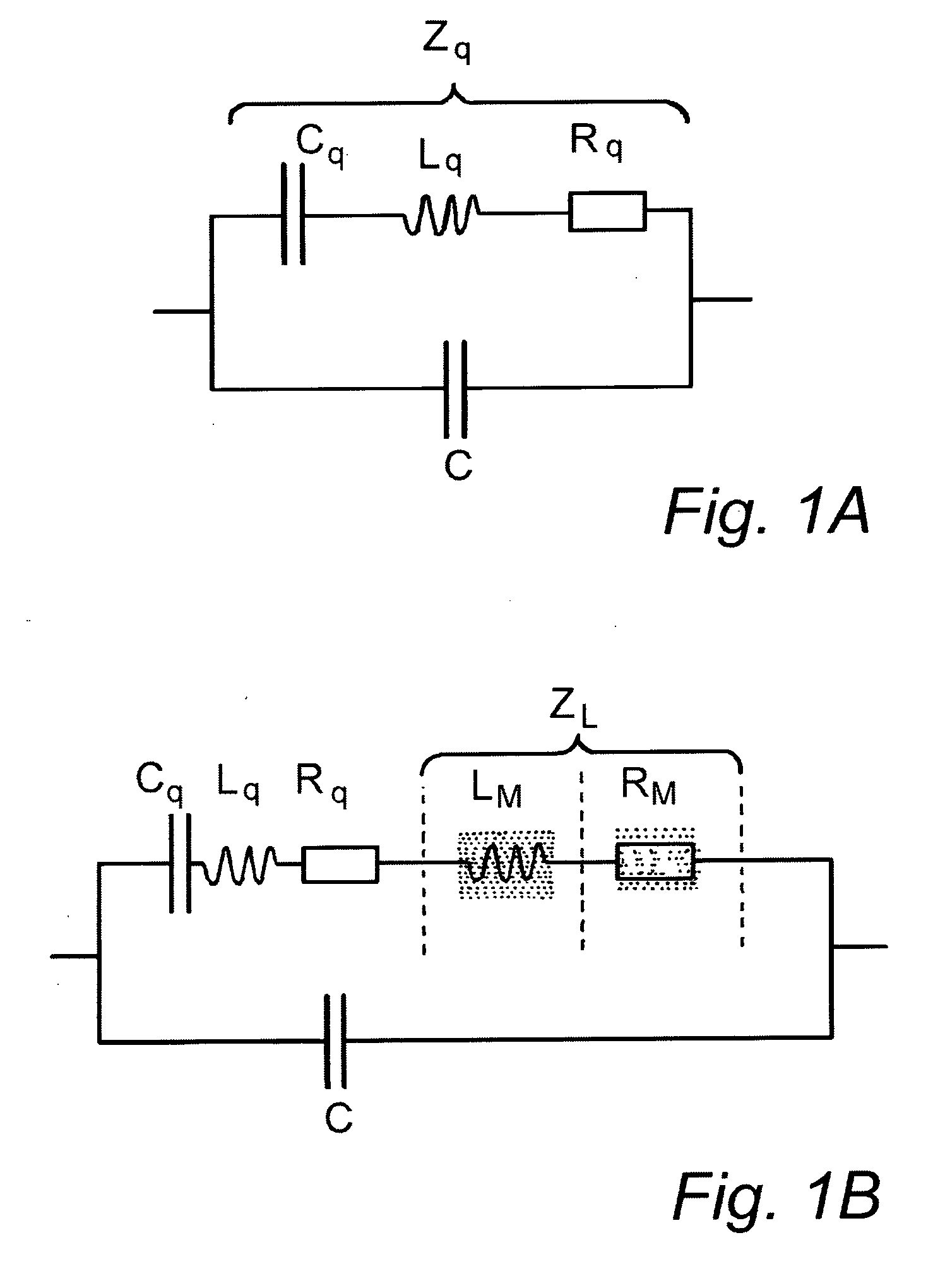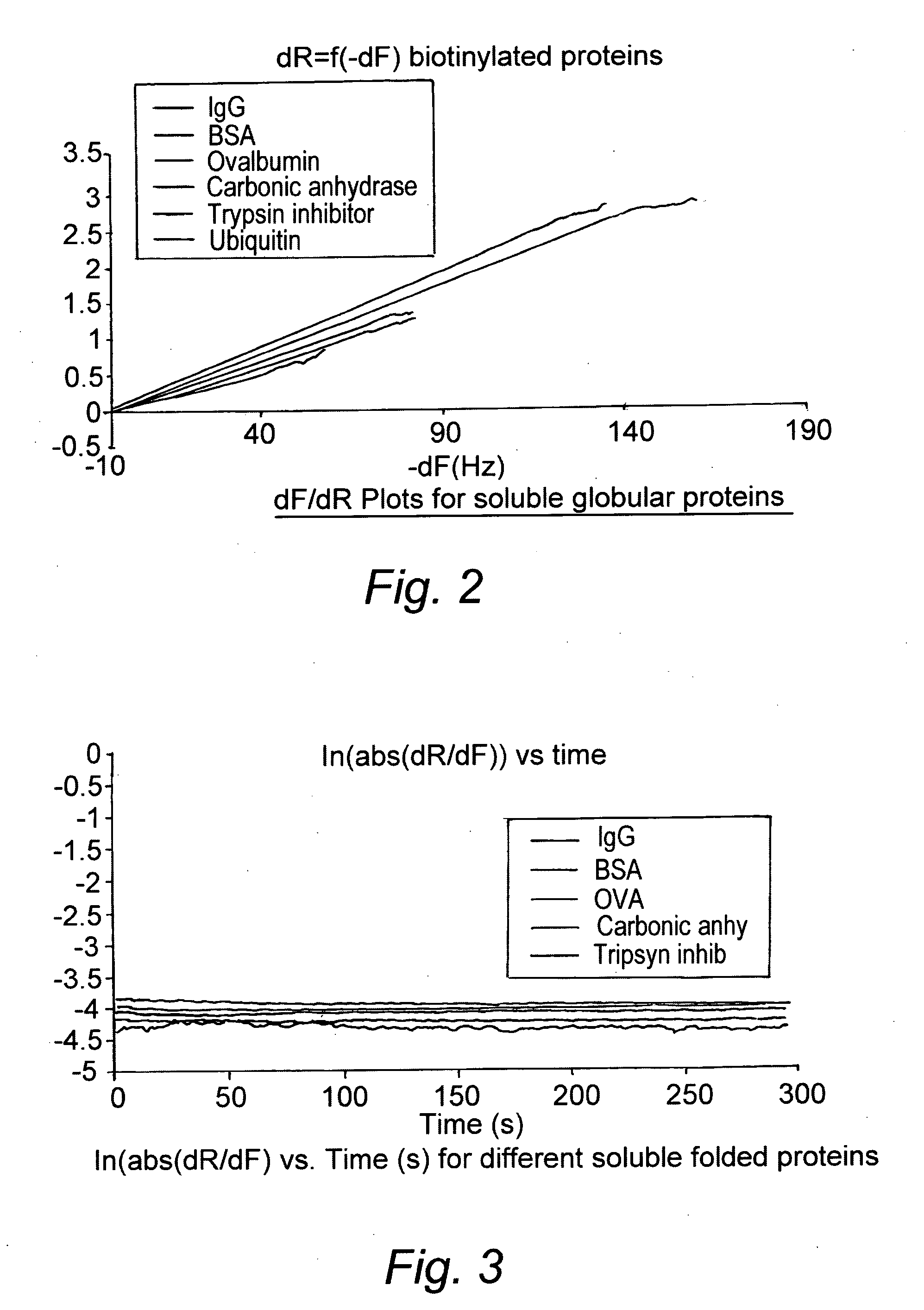Detection and/or Characterisation of Oligomers
a technology of oligomers and analytes, applied in the field of detection and/or characterisation of oligomers, can solve the problems of inability to discriminate between entities in this way, inability to generalize between whether these recognition sites are recognized, and inability to achieve discrimination between entities, so as to improve the selectivity and sensitivity of oligomers
- Summary
- Abstract
- Description
- Claims
- Application Information
AI Technical Summary
Benefits of technology
Problems solved by technology
Method used
Image
Examples
example 2
[0148]Typical apparatus useful for performing the method of the invention is as follows.
[0149]In use, an analyte fluid is passed into a flow cell (e.g. as described in WO 02 / 12873), and the sensor is operated in the way described below. An associated computer causes a synthesizer to generate a sinusoidal signal at a starting frequency and then progressively to increase the frequency to a given maximum. The range of frequencies spanned is intended to include the resonance frequency of the sensor (and any substance bound onto the receptors immobilised thereon). As the variable frequency signal is fed to the sensor, its admittance is measured by a receiver, and this is stored in the computer as a function of frequency. The admittance can be used to provide a measurement of the resonance frequency of the sensor, and / or the Q factor of the sensor (with the bound substance) in the fluid medium. For example, the frequency at which the admittance is at a maximum will correspond to the reson...
example 3
Biotinylation of Proteins
[0152]Protein biotinylation was achieved using Immunoprobe biotinylation kit from Sigma-Aldrich (Catalog No. BK-101). Biotinylation was performed by reacting the protein with the water-soluble reagent BAC-SulfoNHS. Following the reaction, the biotinylated protein was separated from the by-products by a gel filtration column (Sephadex G-25 catalog No. B 4783) using 0.01M Phosphate Buffered Saline (PBS) pH 7.4 as eluent. Consequently the biotinylated protein stock solutions were in that buffer. The ratio of biotin to protein was determined by the avidin-HABA assay. The absorption of the avidin-HABA complex at 500 nm decreased proportionally with increasing concentration of biotin as the HABA dye was displaced from avidin due to the higher affinity of avidin for biotin.
[0153]Molar ratios of BAC-SulfoNHS to protein of between 3:1 and 5:1 were used to obtain a biotin to protein ratio around 1.
[0154]For consistency, the non-biotinylated proteins used as controls w...
example 4
Misfolded / Aggregated Analyte
[0161]Rabbit anti-mouse was covalently coupled to all the sensor surfaces, and mouse anti-A-beta monoclonal antibody (5 μg / ml, 0.33 nM) was captured onto all 4 surfaces. A-beta and control peptides were injected across individual surfaces, as shown schematically in FIG. 4. The numbers (1-42), 1-11 etc. refer to the number of amino acid residues in the peptide)
Reagents:
[0162]1) Deionised H2O sterile-filtered & degassed.[0163]2) Running buffer PBS[0164]3) EDC 0.4M[0165]4) NHS 0.1 M[0166]5) Coupling buffer: 10 mM Na-Acetate pH 5.5[0167]6) Ethanolamine 1M pH 8.5 (all coupling reagents from Coupling kit, expiry February 2007[0168]7) Rabbit anti Mouse IgG (Jackson 315-005-008 lot: 64640, 2.4 mg / ml)[0169]8) 6E10 mouse monoclonal anti-A-beta, 1 mg / ml, 5 μl aliquots obtained from BioQuote-Signet[0170]9) Mouse anti-biotin (Jackson, lot 64880, 1.3 mg / ml) was obtained from Stratech.[0171]10) A-beta1-42 0.5 mg aliquots of lyophilised powder obtained from American Pept...
PUM
 Login to View More
Login to View More Abstract
Description
Claims
Application Information
 Login to View More
Login to View More - R&D
- Intellectual Property
- Life Sciences
- Materials
- Tech Scout
- Unparalleled Data Quality
- Higher Quality Content
- 60% Fewer Hallucinations
Browse by: Latest US Patents, China's latest patents, Technical Efficacy Thesaurus, Application Domain, Technology Topic, Popular Technical Reports.
© 2025 PatSnap. All rights reserved.Legal|Privacy policy|Modern Slavery Act Transparency Statement|Sitemap|About US| Contact US: help@patsnap.com



